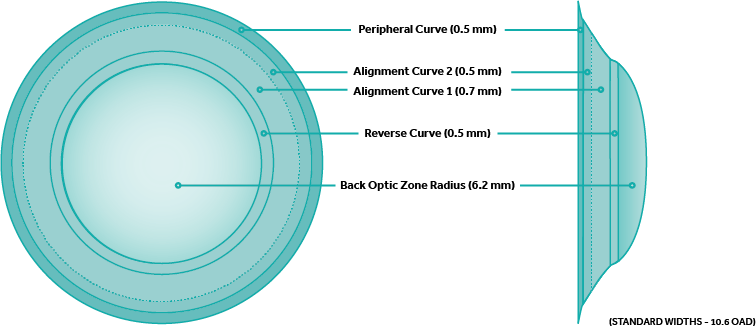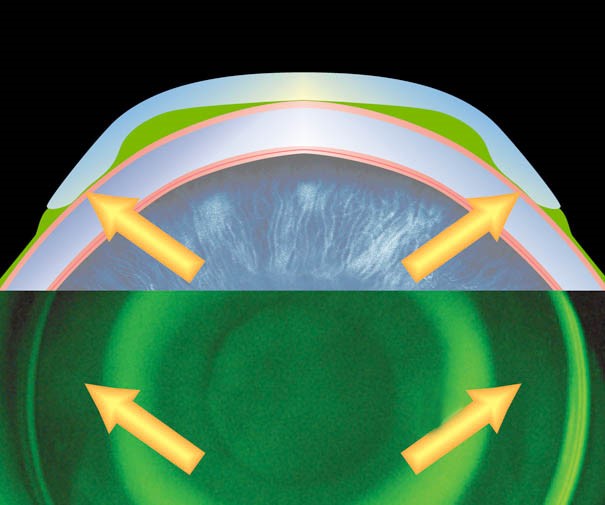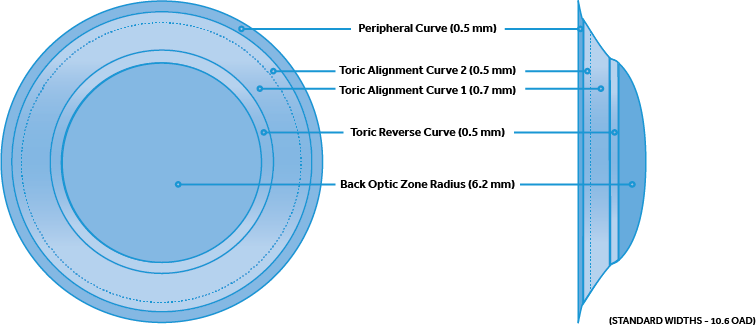
Module 2
THE FUNDAMENTALS
At the end of this module, you should be able to:
- Define orthokeratology
- Describe the corneal shape changes that occur when wearing a Euclid Ortho-K lens
- Describe the different lens designs offered in the Euclid family of lenses
- List the different curves of the Euclid Spherical and Euclid Toric lens designs
- Identify the purpose of each curve for providing the optimal lens fit and orthokeratology effect
- Outline the differences between the Euclid Spherical and Euclid Toric lens designs
What is Orthokeratology?(1/8)
Orthokeratology with Euclid lenses refers to the process of temporarily reshaping the cornea to correct myopia up to -5.00 diopters in eyes with astigmatism up to -1.50 diopters. To achieve this corneal reshaping, a precise lens device is used to gently mold the corneal epithelium through the fluid dynamics of the tear layer under the lens. Euclid lenses are designed to be worn only at night, with no daytime wear required. After a period of adaptation, the cornea reshapes, resulting in myopic reduction throughout the patient’s waking hours. This process is completely reversible, and the cornea will return to its original shape upon discontinuation.
What are Orthokeratology Lenses? (2/8)
Orthokeratology lenses are sophisticated reverse geometry designs with state-of-the-art fabrication. A practitioner will take a patient’s baseline ocular measurements and use these to select the lens design that will gently reshape the corneal epithelium. Over the course of approximately two weeks, the cornea will reshape during overnight wear due to the compression and redistribution of cells with pressure from fluid dynamics.
Corneal Shape Change (3/8)
Orthokeratology lenses work by exerting hydraulic forces between the back surface of the lens and cornea, causing a gradual compression and redistribution of tear fluids under the lens from the center towards the periphery of the cornea. The central corneal epithelium becomes thinner because of positive pressure under a flat central curve of the lens, while the mid-periphery becomes thicker due to the negative pressure created by the annular tear pool under a steeper curve, called the reverse curve. This change in the distribution of the epithelial cells creates a new refractive surface for the cornea and temporarily corrects the myopic refraction.
Choo, Caroline, et al: Morphologic changes in cat epithelium following continuous wear of orthokeratology lenses: A pilot study
Image reproduced with author’s approval
Euclid Emerald Lens Designs (4/8)
The Euclid Emerald lens was the first Euclid lens approved by the FDA in 2004 under PMA P040029 and P010062 as the Euclid Systems Orthokeratology Contact Lens for overnight wear. Euclid lenses are available in two designs, each meant to provide the best shape to naturally fit your patient’s corneas. The Euclid lens design is a rotationally symmetric design, while the Euclid Toric lens design is rotationally asymmetric. We will review the recommended use of these designs in our next module, “Patient Selection.”
Lens Materials (5/8)
Orthokeratology lenses can be worn overnight due to innovations in the oxygen permeability of lens materials. When ordering Euclid lenses, practitioners can choose from two materials, which are both approved by the FDA for Euclid Emerald overnight orthokeratology.
- Euclid Emerald and Euclid Emerald Toric manufactured in Oprifocon A, Dk 85*
- Euclid MAX and Euclid MAX Toric manufactured in Tisilfocon A, DK 180*
*ISO/Fatt (polarographic)” – This was in the original content document, and describes the technique used to measure the oxygen permeability / Dk.
Euclid Spherical Lens Mechanics(6/8)
The Euclid MAX and Euclid Emerald lens designs are a five-curve, rotationally symmetric lenses. Each curve plays a different role in reshaping the cornea. The spherical lens is comprised of the following curves:
- Base Curve
- Reverse Curve
- Alignment Curves 1 and 2
- Peripheral Curve
Note: Widths shown for a standard 10.6mm overall lens diameter
Base Curve
The base curve is the first curve of the Euclid lens and is calculated to be flatter than the central corneal radius in relation to the amount of myopia being corrected. This curve provides positive pressure that results in the compression of the central corneal epithelium. The standard width of the base curve is 6.2mm, which creates an effective corneal treatment zone of 5mm or more.
Reverse Curve
The reverse curve is the second curve, and is dramatically steeper than the base curve, forming an annulus shaped tear reservoir and inducing negative pressure on the cornea. The reverse curve provides an area for the intracellular fluid to accumulate.
Alignment Curves 1 and 2
The third and fourth curves are the alignment curves, which mimic the shape of the cornea to provide optimal lens centration. The radius of the first alignment curve is generally the flat keratometry reading, while the second alignment curve is 1.50D flatter than the first to mimic the increased flattening of the cornea toward the periphery.
Peripheral Curve
The fifth curve is the peripheral curve. The peripheral curve is flatter than any of the proceeding curves to provide an adequate edge lift for lens comfort and movement, along with tear and debris exchange.
Euclid Toric Lens Mechanics (7/8)
The Euclid MAX Toric and Euclid Emerald Toric lens designs are five-curve, rotationally asymmetric lenses. The lens parameters are identical to that of the Euclid spherical design with one key difference: while the base curve and peripheral curve remain symmetrical, the reverse curve and alignment curves are asymmetric, providing a closer corneal fit. So, while the Euclid Toric lens does not provide any optical correction for astigmatism, it can provide better corneal alignment and improve the patient’s overall outcome.
Note: Widths shown for a standard 10.6mm overall lens diameter
Summary(8/8)
In this module, we discussed:
- The process of orthokeratology is the use of a precise lens device to gently reshape the cornea and temporarily correct myopia
- When wearing an orthokeratology lens, fluid forces change the cornea to make it thinner towards the center and thicker towards the mid-periphery
- The Euclid spherical lens is a rotationally symmetric five-curve lens design comprised of the base curve, reverse curve, alignment curves (1 and 2), and peripheral curve
- The Euclid Toric lens is a rotationally asymmetric five-curve lens design with asymmetric reverse and alignment curves to provide a closer corneal fit
- Each lens curve of the Euclid lens plays an important role in reshaping the cornea to provide the optimal correction of myopia









